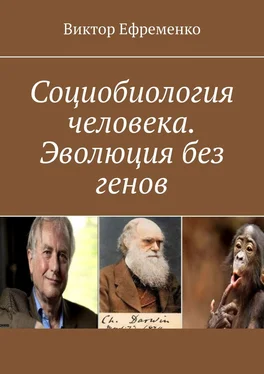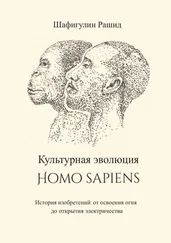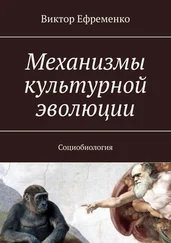Социобиология человека. Эволюция без генов
Социальная (культурная) эволюция
Виктор Андреевич Ефременко
Иллюстратор Виктор Андреевич Ефременко
© Виктор Андреевич Ефременко, 2019
© Виктор Андреевич Ефременко, иллюстрации, 2019
ISBN 978-5-4485-1651-1
Создано в интеллектуальной издательской системе Ridero

Introduction. Cultural evolution
The book is devoted to the popular presentation of some questions of the new science of human society – Sociobiology of human.
Sociobiology of human is a system of Sciences, the object of study of which is the species Homo Sapiens, its behavior in societies, selection rules that make societies stable enough, methods of manipulating its behavior, conditions leading to revolutionary changes. Culture should be considered as the result of non-morphological, functional adaptations of the brain Homo Sapiens, changing human behavior in the social environment.
Modern man in the form as we know it, is not created by Darwinian biological evolution alone. This evolution has created species Homo sapiens, which as a result of cultural evolution has become a modern man. The cultural evolution of this species was able to move much further than all other species from the order of primates. In biological evolution in the process of natural selection, a morphology (structure) of organisms changes with the memorization of selected characteristics by fragments of the DNA molecule, genes.
A DNA molecule has the remarkable property of creating its own copies (replicated).
For any evolution of the living, replicators are needed, without which evolution is impossible.
Genes are such replicators for all biological evolution. With the advent of nerve cells, and then the brain in multicellular organisms, they were able to accumulate in it some experience throughout life. Experience in higher mammals plays a big role in their lives. This experience can not be transferred to the next generation by genes, as morphological properties are transmitted. Their own experience, everyone must assimilate himself and the fate of the individual largely depends on the success of this assimilation. The process of remembering in the brain is not a process of changing its structure, it is a change in its functions, i.e. functional transformations.
The book developed and proposed a model of the mechanism of non-genetic inheritance of functional adaptations of the brain, which manifest themselves in human behavior as a change in its mentality.
This mechanism is made up of interactive brain programs called MEMs, that can replicate. This applies to all living beings with the brain. Transfer of skills, knowledge in populations is a well-known fact. However, replication of brain programs is possible only in individuals in the same population. This transfer can be called horizontal. This MEMs as replicators differ from genes that transmit information to subsequent generations of the population, being replicators of the vertical type.
Man stands out from all the representatives of the order of primates in that he managed to create a system of non-genetic inheritance of the experience of previous generations. This actually allowed him to become the dominant species on the planet. The developed language of communication, socialization, sufficient intelligence and, finally, the creation of writing, these are the main factors that made possible the transfer of cultural inheritance (functional adaptations) in a non-genetic way.
The creation of writing should be regarded as the appearance of external memory, which helps to organize cultural inheritance in the human society. MEMs become full-fledged replicators that allow vertical replication. The acquired experience and knowledge can now be easily transferred to subsequent generations.
Traces of human activity throughout the historical period should be seen as a manifestation of its cultural evolution. It is not right to talk about the evolution of culture in itself. Culture is the result of human activity, it is he who evolves in a non-genetic way, and therefore the evolution of his cultural manifestations in society is observed. All other primates who do not have a developed language of communication, especially ways of fixing functional adaptations of the brain with the help of writing, have stopped on the halfway point of cultural evolution.
Sometimes human behavior is suggested to be analyzed on the basis of the laws established by ethology (the science of animal behavior). But this approach does not take into account:
1.That the human mind, its communicative abilities are qualitatively different than in other animals. 2. The degree of socialization of man is also much greater than even in the eusocial communities of ants, bees and other insects from the order of the Hymenoptera. 3. In addition, to draw conclusions about the functioning of a supercomputer based on the study of the device calculator is not entirely correct.
The book details the reasons why a man can not already be considered in the evolutionary plan as a representative of primates within the framework of biological science, and for it, consideration within the framework of sociobiology is required.
Therefore, sociodarvinism, as an attempt to apply exclusively biological regularities to explain human behavior, is untenable.
Eusocial insects belonging to the order of the Hymenoptera, which includes bees, ants, termites in the way of socialization, without much intelligence, also proved to be very successful in biological criteria of reproduction and survival. But they have neither a reasonable mind nor a developed communication language, let alone writing, to create their own adequate human civilization.
About 50 thousand years ago there were about 6 species of anthropoid apes. As a result of natural selection, only one species of Homo sapiens, which appeared about 180,000 years ago in the family of hominids in Africa, has survived from them. This species, which for some time has been called a man, has become the dominant species on the planet.
It differs from other species in that the adaptations acquired by it in the process of evolution are not morphological (strong legs, sharp fangs, etc.) but functional adaptations of the brain. They are not transmitted by genes, but only by brain structures. This evolution is called social or cultural. This is an evolution without genes.
For the first time the idea of replicators of culture was expressed by R. Dawkins. Clinton Richard Dawkins (March 26, 1941) – English ethologist, evolutionary biologist, scientist and popularizer of science. R. Dawkins became famous in 1976, when his book «The Selfish Gene» was published, in which the term «mem» was introduced into the lexicon, denoting a unit of cultural information (analogous to a gene in genetics) copied and transmitted from one carrier to another and subject to mutation, natural selection and artificial selection. According to
R. Dawkins, «meme» is an idea in consciousness. The new view developed in this book is to consider them not as ideas in the mind, but as interactive brain programs that are localized in places of the brain that are inaccessible to consciousness (according to Freud) – in the unconscious or in the subconscious. Therefore, I had to change the spelling of the term on MEM.
Читать дальше













